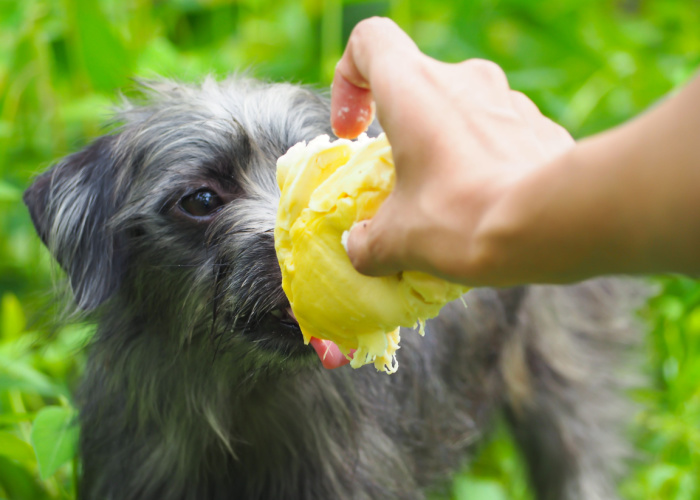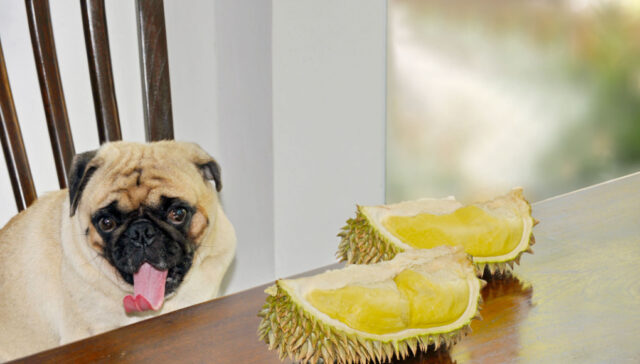
Table of Contents
So, the big question “Can dogs eat durian?” continues to baffle me as a dog parent to a curious, heavy chewer and a dessert machine pooch.
That’s because people love this tropical fruit, and it looks like my pup will enjoy some, too.
But after thorough research, you’ll probably argue with me on this…
Durians are not suitable for dogs.
Of course, I’m not just going to say it because I (honestly) hate durians.
But because my good friend here, science, has something to say about dogs eating durian.
Don’t get me wrong. Fruits are a vital source of nutrition for canines.
But Dr. Ellen Malmanger of PetMD says:
Due to the balanced nature of high-quality, nutritionally complete commercial diets, it’s not necessary to supplement your dog’s diet with fruits, but it can be fun to use them as treats.
Also, the right question to ask should be:
“Is durian safe for dogs?”
So, you might want to buckle up and put your glasses on. We’re bound to discover some serious stuff.
Without further ado, let’s begin!

Can Dogs Eat Durian: 3 Reasons Not to Feed This Fruit to Your Pups
Despite its distinct aroma, the durian fruit is loved by many.
And as soon as you bite that creamy flesh, your dog stares at you with that adorable begging eyes.
Can you resist?
Well, as a pet guardian, you should.
And here’s why.
1. Durians are High in Fat
A study claims that high-fat diets can easily cause obesity in dogs.
…feeding a high-fat diet is associated with insulin resistance, reduced brain insulin transport, decreased microbiota α-diversity, and reduced abundance of Prevotella, Solobacterium, and Coprobacillus.
When your dogs consume a high-fat meal, the list of health complications includes the following:
Pancreatitis
This medical condition is characterized by inflammation of the pancreas.
The pancreas produces enzymes to assist in food digestion and hormones such as insulin, which regulates blood sugar or glucose metabolism.
If you suspect your pooch is suffering from pancreatitis, watch out for the following symptoms:
- Fever
- Nausea
- Vomiting
- Diarrhea
- Lethargy
- Abdominal pain
- Decreased appetite
Without the pancreas, your dog will rely on diabetes treatment throughout its lifetime.
So, to help prevent your dogs from pancreatitis, avoid feeding them high-fat foods like durian.
Note: This disease is directly related to obesity and diabetes in dogs, too.
Intestinal Dysbiosis
Speaking of diabetes, dogs suffering from one are found to have a bacterial imbalance or intestinal dysbiosis.
Unfortunately, certain diseases are not the only culprit here.
A study found that fat contributes to “changes of gut microbial community structure” in canines.
High-fat diets also play a big role in the overgrowth of pathogens or bad bacteria (like Proteobacteria) in your dog’s gut.
Proteobacteria is a major group of bacteria which includes Salmonella.
And an overabundance of this pathogen can cause metabolic disorders and inflammatory bowel disease in your dogs.
For your reference, symptoms of bacteria imbalance in your dog’s gut include the following:
- Diarrhea
- Vomiting
- Weight loss
- Decreased appetite
As a form of prevention, you’ll need a more holistic approach for your beloved pups, which are the following:
- Prebiotics and/or probiotics
- Switch to a low-fat, high-fiber diet
Hyperlipidemia
Note: Fats are not bad for your dogs at all.
In fact, the 2 most important lipids (fat molecules) in your dog's body are cholesterol and triglycerides.
These lipids cannot be dissolved in your dog’s bloodstream if not because of the lipoprotein complexes that your pup’s body forms.
And for healthy dogs, fat levels typically rise for a short time after meals, returning to normal after a few hours.
But in the case of hyperlipidemia, the opposite is true.
Without regulation, both dogs and cats can suffer from hyperlipidemia or too many fat molecules in the bloodstream.
While underlying health conditions (i.e. diabetes, liver, and kidney disease) directly trigger hyperlipidemia in dogs, high-fat foods are also contributing factors.
Important: Hyperlipidemia may not necessarily show signs in your dog’s body unless other health condition arises.
If you’re constantly feeding high-fat foods like durians to your dogs, they’ll likely develop heart issues.
So, watch out for the following conditions:
- Chest pain or pressure
- Blockage of blood vessels in the brain and heart
Other indications of too much fat molecules in your dog’s bloodstream include the following:
- Vomiting
- Diarrhea
- Pancreatitis
- Abdominal discomfort or pain
- Yellowish plaques near the eyelids
- Yellow or creamy fat deposits in the cornea of the eyes
- Yellow, cholesterol-filled skin lesions (tissue damage)
- Creamy appearance of blood vessels in the retina of the eyes
To prevent this life-threatening condition, your dogs need a low-fat, high-fiber diet along with enough exercise.
2. This Fruit is High in Sugar, Too
Well, sugar isn’t technically toxic to dogs; it’s a carbohydrate.
But this cliché statement, “Too much of something is bad,” still applies.
So, I went on and researched the 2 factors to key in when talking about the negative effects of sugar on dogs.
Understanding the Role of Carbohydrates
So, let’s draw the line on how much sugar (carbohydrate) your pups should be consuming.
As you may know, your dog’s body needs carbs to supply energy for its system to function optimally.
But there are actually 2 types of carbs — simple and complex.
|
Simple Carbohydrates |
Complex Carbohydrates |
| Plain | Contain starch or fiber |
| Comes in processed goods like cake, candy, and ice cream | Present in whole grains, vegetables, fruits, |
| Rapidly increases or spikes the body’s blood glucose level | Slowly increases the body’s glucose level over a longer period of time |
| Unhealthy form | Healthy form |
Does that mean the durian fruit is actually healthy for dogs?
Well, yes, the durian fruit is home to lots of vitamins, minerals, and antioxidants.
But the truth is, too much complex carbs in your dog’s system can turn into simple forms, which poses a health risk.
This phenomenon is also common in some ingredients in dog food brands that contain too many complex carbs like:
- Corn
- Rice
- Wheat
- White potatoes
What is Canine Salivary Alpha-Amylase?
Salivary alpha-amylase is an enzyme produced by the salivary glands that help digest starch (complex carbs) into smaller, digestible molecules.
While hoomans produce high levels of salivary amylase which allows for breaking down starchy foods like bread and pasta easily, your pups unfortunately can’t.
A study found that:
…dog saliva had lower amounts of alpha-amylase than human saliva which is possibly due to the natural selection associated with digestion capability and food appreciation.
If complex carbs take more than 30% of your dog’s diet, it will likely struggle to break them down properly.
This can only cause digestive problems such as:
- Bloating
- Diarrhea
- Vomiting
And since dogs lack the digestive enzyme to break down complex carbs, they usually convert carbs into sugar.
Thus, resulting in weight gain and obesity.
You can also notice spurts of energy followed by extreme exhaustion after your dogs eat too much carbs.
But don’t get me wrong—carbs are vital for your dog’s nutritional needs.
And remember, only in moderation.
RELATED: Do You Know Your Dog’s Nutritional Needs?
3. Parts of Durian Fruit Contain Cyanide
Just like apples (seeds) and plums (pits), the durian fruit contains traces of cyanide.
Although relatively low in amount, cyanide is still a potential risk to your pets.
Especially eaten in large quantities, dogs eating durian can show symptoms of poisoning such as the following:
- Nausea
- Vomiting
- Diarrhea
- Weakness
- Loss of appetite
The seeds, where traces of cyanide can be found, should not be eaten raw or cooked by your dogs.
That’s because durian seeds contain cyclopropene fatty acids, which are known to cause cancer.
The chunky seed is also a choking hazard for your Fidos.
So, it’s practical to keep your pups away from it.
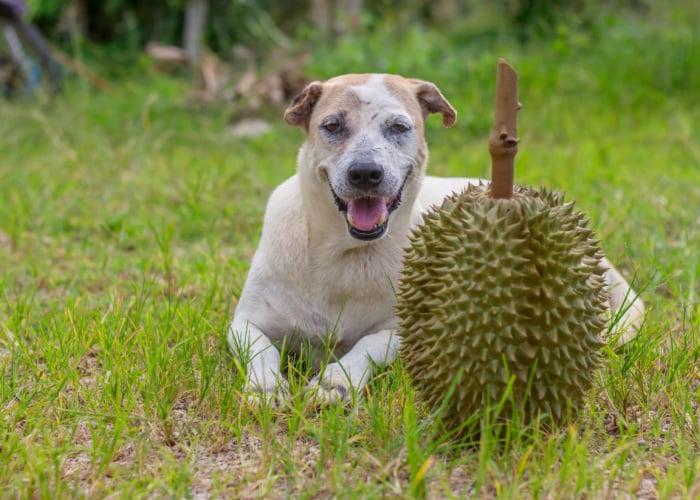
Can Dogs Eat Durian: Poisoning First Aid
For your dog’s general safety, call the Pet Poison Helpline at (855) 764 – 7661.
The Pet Poison Helpline is a 24/7 animal poison control center considered to be the only licensed veterinary contact center in the world.
In cases of emergency, the Pet Poison Helpline suggests the following instructions:
Step 1: Remove your dog from the area immediately.
Step 2: Check your dog for any breathing difficulty or abnormal reactions.
Step 3: Do not give any at-home medications or self-remedies.
Step 4: Avoid forcing your dog to vomit without consulting your vet or Pet Poison Helpline.
Step 5: Call Pet Poison Helpline or contact your vet immediately.
You can also contact the following helplines below:
- America’s Poison Center (800) 222 -1222
- The Animal Poison Control Center of the ASPCA (888) 426 – 4435
Important: Be sure to have your vet’s active contact lines in case the above hotlines are not available.
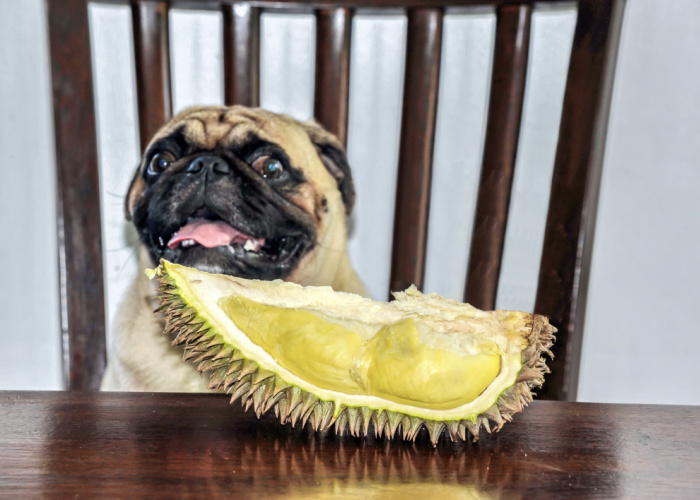
Emergency: What if My Dog Swallowed a Durian Seed?
1. Remove Your Dog or the Object From the Area
Get rid of any pieces of durian seed in the area and secure your dogs to a safe spot at home.
If you can still remove the chunks from your pup’s mouth, the better.
But don’t force your dogs to vomit unless supervised by your vet.
Can you perform a Heimlich maneuver on your dogs?
According to James Barr, clinical assistant professor at the Texas A&M College of Veterinary Medicine & Biomedical Sciences:
Pet owners should perform the Heimlich maneuver on their pet if they believe the pet is choking on something.
Note: Only perform the Heimlich maneuver if you do not have enough time to visit the vet. Ideally, have your vet on the phone to help walk you through the process.
For small and large canines, here’s a set of instructions for choking dogs:
Heimlich Maneuver for Small Dogs
Method 1
Step 1: Pick up your dog and hold it with its back to your front.
Step 2: Find the soft spot on their abdomen under their ribs.
Step 3: Using the thumb side of your fist, gently thrust inwards and upwards.
Method 2
Step 1: Lay your dog on its back.
Step 2: Find the soft spot on the abdomen under the ribs.
Step 3: Using the heel of your hand, gently press inwards and upwards.
Heimlich Maneuver for Large Dogs
Method 1
Step 1: Stand your dog on its hind legs and hold them like a person with its back to your front.
Step 2: Find the soft spot on the abdomen under the ribs.
Step 3: Using your fist, thrust inwards and upwards.
Method 2
Step 1: Lay your dog on its side.
Step 2: Find the soft spot on its abdomen under the ribs.
Step 3: Supporting your dog from the back, press a fist upwards and inwards toward its spine.
2. Avoid Giving DIY Remedies to Your Fido
Besides water, avoid giving at-home medications to prevent any possible allergic reactions.
Letting your pups take DIY remedies without your vet’s signal can worsen their condition.
3. Let Your Vet Know
Call your vet and let them know all the necessary details of the incident, including how much durian seed your dog might have eaten.
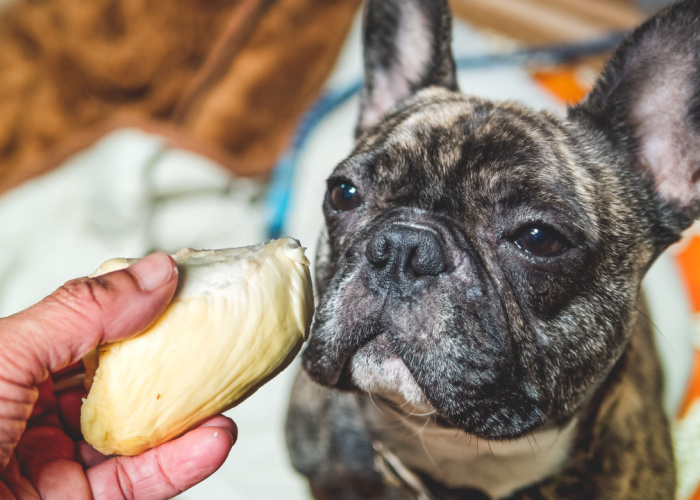
Can Dogs Eat Durian: FAQs
How much durian should dogs eat?
Your dogs should eat durian that’s proportionate to their age, weight, or breed.
For safety reasons, only feed your dogs a small amount of durian flesh occasionally.
And most importantly, consider your vet’s advice on feeding durian fruit to your dogs.
Especially if your dogs have underlying health problems, eating durian fruit can worsen or trigger some conditions.
Which parts of the durian fruit can dogs safely consume?
Your dogs can safely consume the durian flesh and nothing else.
Durian seeds, stems, and pits are not suitable for your dogs to munch on as they contain toxic properties like cyanide and cyclopropene fatty acids.
These durian parts are also potential choking hazards for your dogs.
So, be sure to keep these away from Fido.
Can dogs eat durian candy?
Dogs should not eat durian candy or other processed forms.
That’s because the ingredients usually contain milk and other dairy products that are not advisable for lactose-intolerant dogs.
Plus, durian products contain loads of sugar that are harmful to your dogs.
So, it’s best to stick to your vet-recommended diet and treats all the time.
Can Dogs Eat Durian: Before You Go…
Whether can dogs eat durian or not, it’s vital to take your pup’s vet-recommended diet into consideration at all times.
It’s also good to remember that not all hooman foods are advisable for your dogs.
So, it’s practical to be on the safe side as much as possible.
Found this blog helpful?
You might want to check out a few top picks below, too!


